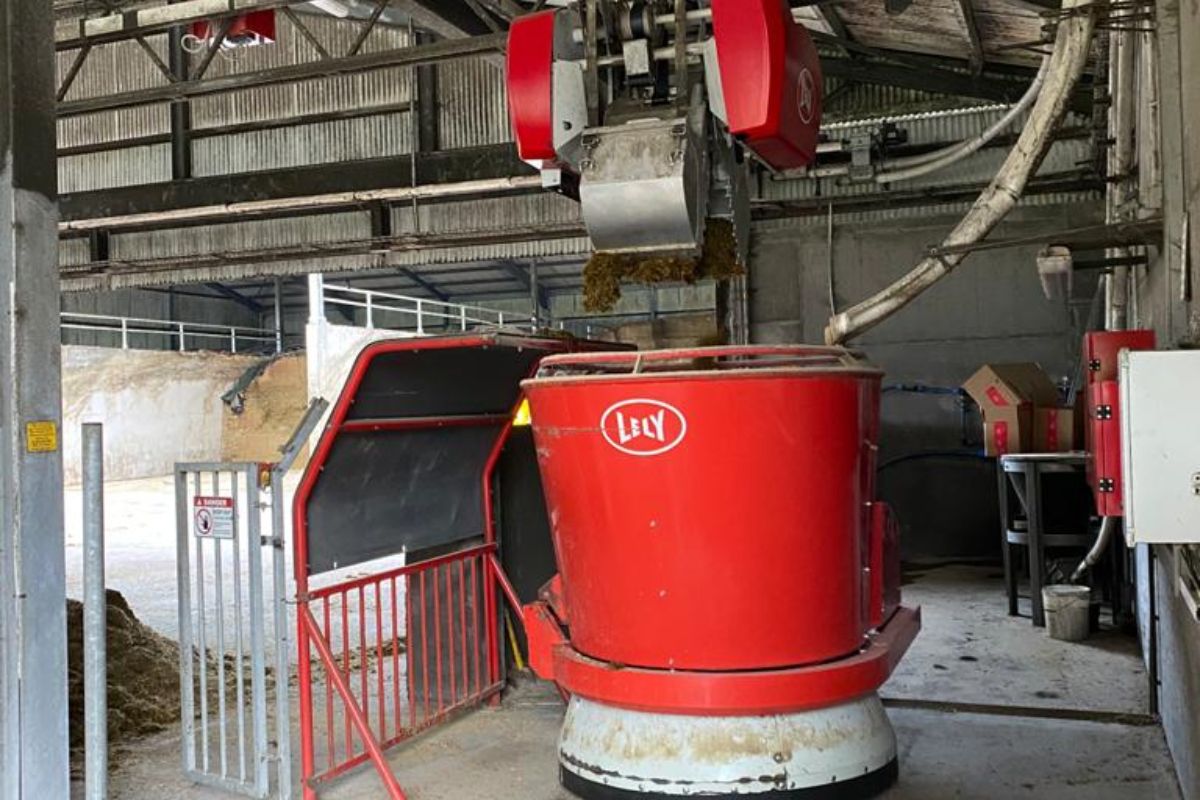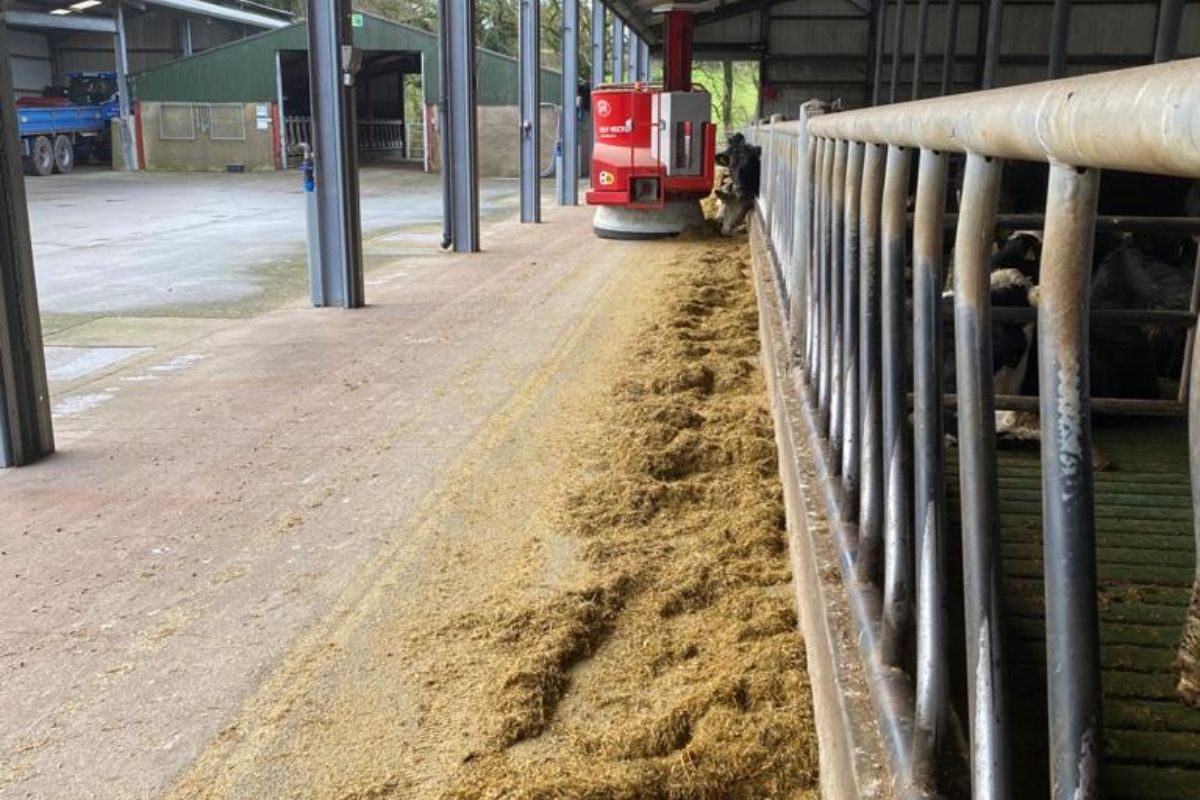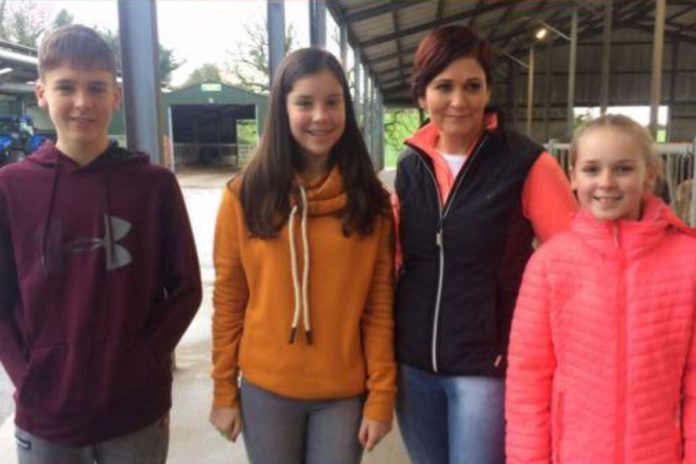In this week’s Farmer Focus, That’s Farming, speaks to Aine Sweeney of Glen South Farm about managing Europe’s first-ever robotically operated Lely feeding system on a beef farm.
In 2013, Frank, CEO of Monex Financial Services, and Theresa Murphy took over Glen South Farm in County Cork after the passing of Theresa’s father.
Aine Sweeney, from County Kerry, worked closely as an employee of Monex Financial Services for over eighteen years.
However, for the past six years, she has held the position of farm manager at Glen South Farm.
“I fell into the job by accident. I came to set up the computer and fell in love with the whole lifestyle of working with animals. So, I had no farming background before I started the role,” she told That’s Farming.
“When you come from working in an office, you are constantly watching the clock and going 10 am is for tea and lunch break is in a half-an-hour and 2 hours we are going home.”
“On a farm, you could throw your watch away; it is beautiful, is the only way I can describe the lifestyle of farming. You go by daylight, and your belly that is how you figure out what time of the day it is.”
Glen South Farm
Glen South Farm is a 1,200 strong beef finishing unit with a 400-acre grazing platform. These parcels of land comprise 340-acres of grassland and 60-acres of tillage. The home platform is a 200-acre farm with another 200-acres split into two out-farms.
“When I came on board so that I could manage the farm easily, I got Grasstec to map the farm. They put them in paddocks to ensure I had paddocks with two day’s grazing and a water trough in every paddock. So I would have the farm divided into three different areas.”
“We would soil sample every two years, and we put the fertiliser out for what it needs. Then, for the liming program, I would try to keep all that right to improve soil health
The farm manager noted that when Frank and Theresa Murphy took over the enterprise’s reins in 2013, it comprised 100-acres.
“Farms nearby came up for sale, so Frank invested. Then, as years went on, if something [land] looks good, he will buy it.”
“We are not fussy about what animals we take in. Whatever is in the mart, we buy bullocks or heifers. It has worked out that we are 50:50 for the last two years.”
“Once they come in, they are turned around in 60 days. After that, we bring in bullocks into the farm at 500kg plus and heifers at about 450kg. Our diet consists of 10kg of silage, 8kg of maise, 6kg of whole crop wheat, and a 4kg of a finishing ration.”
Aine noted that the farm’s position in North Cork led to the choice of breed. Today, the farm has a 98% herd of dairy crossed animals. “Around here [Cork], they all seem to use Angus and Hereford, so that is what we would be using.”
“In the last twelve months, we are putting on 1.5kg [daily live weight gain] on our heifers on average; our bullocks are averaging 1.7kg. Everything goes to ABP Rathkeale in Cork.”
Arrival policy
On arrival to the farm, Aine has a strict arrival policy for heifers and bullocks. “When they arrive at the farm, we have a smaller holding we put them into relax for 3 to 5 days.”
“Then, I will introduce them in the shed. I will vaccinate the cattle clip backs and tails and dose them. The group that comes in together stays together for their 60 days. They are not moved or mixed.”
“We had a very good year last year, all winter. We used no antibiotics in the shed by the way we introduce them into the shed, and we try to keep them together.”
“They go into the big pens together, and we do not move them; the less stress, the better. So the [Lely Vector] robot helps with that because they are never stressed waiting for feed; there is a calmness.”

Lely Vector
In the winter of 2013, Frank invested in the innovative Lely Vector feeding robot.
“When Frank was designing the shed, Lely approached him about the idea of putting in a Lely Vector. He went to Holland to look at some robots working and fell in love with the idea of it; that is how we came to putting in a Lely Vector in.”
“It would have been going for that winter, and then I would have come on board the following summer. So it was only trial and error. It was the first Lely Vector robot put into feed beef animals in Europe.”
Heifers and bulls are fed on average seven times a day, with the Lely Vector robot passing every 40 minutes.
“The quieter ones [animals] will be waiting on it [the robot] when they come forward. They are still getting the same quality and amount of feed as the bigger ones up the front. The mix is the same, and it is fresh all-day-long.”

Features
On the Cork-based farm, ‘Mr Vector’, christened by Aine and the Murphy family, completes three tasks daily, including mixing and distributing each load, pushing in the feed and measuring the ground level.
“I can set it to that when it goes down to 40mm left in the ground; the robot knows he needs to feed that pin again. If the robot is feeding pen one and pen two. as it drives around the next time, it might decide pen four and pen ten needs feeding.”
The robot will come in and mix for them, and then he will go and feed them. As he is driving around, he is constantly measuring, so he is driving for the 24 hours.”
“The whole thing about the Lely Vector it tries to mirror what happens in the field. So, in the pens, they must have enough room to sit down, easy access to water and easy access to food [the same as the field].”
“They can get up and graze when they want, sit down, sleep, or drink some water.”
“The Lely Vector robot is encouraging them to have a nibble every time he passes as they are inquisitive and want to see if he leaves anything. So we put that down to why we have such a good weight gain in our animals.”
Cost of running the Lely Vector
According to Aine, the Lely Vector works out at approximately €70 daily over ten years, operating 24 hours a day.
“The Lely Vector works 24/7 costing €5.25/day to run. The Labour into filling the kitchen area where the food goes in takes me 10 minutes a day to fill the kitchen.”
“You will not get too many people to do that, and the fact that there is fresh food in front of them all the time,” she laughed.
“The only machinery used in feeding the cattle is the loader for 10 minutes to fill the kitchen [the shed the Lely Vector collects the feed] every day.
“So you have no diesel costs and no labour. Whereas if you had a diet feeder, you would have a tractor, a diet feeder, a person, and a loader filling it revved up to the last mixing it.”

Why a Lely Vector?
So, why does Glen South Farm still have a Lely Vector 8 years after its installation? “When you go down to the yard, there is no noise out of the animals.”
“You know, when you walk into a field, and they have loads of grass, they will not even get up for you. That is what the Lely Vector does, and that is what they look like when you go down the yard.”
“The way we feed them is the number one difference. Our diet is not extraordinary; it is the most diet used by most beef finishers; I would put it down to the robot. What makes us special is the robot and ensure the simple things on the farm are right.”
Aine noted that the farm uses other technology, including the Herdwatch app and GPS control, for accurate spreading.
“A GPS spreader section control puts out all the fertiliser, so all fertiliser is put out to what exactly is needed. The grasshopper we use to measure the grass is all GPS which is connected straight to my phone. We are always open to new technology.”
Farm infrastructure
Rebuilt from an old farm in 2013, Glen South Farm hosts a livestock holding unit for animals entering and departing the farm.
“When they [the cattle] are leaving the farm to be loaded, they spend a day or two there [in the departing section], and when they come in, there are two sides to it.”
“One side is for new animals, and the other side is for ones [animals] leaving to relax before they are transported to ABP Rathkeale. All my crush and weanling scales are in the centre of the shed.”
Other infrastructural developments include an isolation unit for animals requiring medical attention and a bigger shed with ten pens, the base shed of the Lely Vector robot.
A day in the life
Furthermore, Aine explained what a winter’s day at the helm of Glen South Farm consists of. “On a winter’s day, when all the cattle are inside, your first job in the morning is to walk all the cattle. Then, all the water troughs in the sheds are washed twice a day.”
“Every morning you are herding, you are washing water troughs. You do the same in the evening every animal is walked in the evening checked, and their water troughed is washed. Then, you would be filling the kitchen [the area the Lely Vector collects the feed].”
“Because we are turning them all the time, new animals are coming and going a couple of times every week. So you are constantly dosing and clipping tails and clipping backs and makings sure all the paperwork is up-to-date.”
“You nearly spend more time these days doing paperwork than anything else. But, because of the Lely Vector robot, we can put that many cattle through with the one staff member.”
“Every animal that goes through our shed, we do an excel sheet on it, with the information the Lely Vector gives me. On the excel sheet, the tag number, their breed, their sex, where it came from, the date of birth, and when it was moved in.”
“When the animal moves out, I can see how many days they were on the farm, how much weight they put on everything is weighed when they are coming in and going out. So I know exactly how much that animal put on when it was with me.”
“I can tell how much exactly it costs to feed that animal while they were here for the 60 days. I can put all my costs into it and know exactly how much we made from every animal.”
Farm responsibilities
Aine revealed is what she believed is needed to run a successful farming enterprise.
“Working on the farm, you have to be the electrician, the plumber, the vet, the accountant and the mechanic. You learn lots of new tasks when you are a farmer. You name it; when you work on a farm, you must be doing a bit of everything.”
“My priority is the animal’s health. Everything else can wait; you need to make sure the animal’s comfort is number one. Because of the Lely Vector robot, you get a different relationship with them after being in the shed for a day or two.”
“The machinery or the humans do not feed them. Usually, if you turn on a tractor in the morning, the cattle will start roaring, or if you pass with a bucket, there is none of that.”
“So they have a relaxed relationship; when you are going to herd them, they do not associate you with feeding them. So they get quite relaxed around you.”
Aine’s priority on the farm “are the small things. “Simple things that you can change on the farm like hygiene, ensuring the feeding is perfect, and their water is constantly clean, and they are happy.”
“It is the small things that make you money. I work very closely with Devenish. Every quarter of my pit, I would send samples away. When they come back, Kieran Conway will sit down and go through it, and we would make sure the diet is balanced.”
“We would change the concentrates to suit what is in my pit to make sure it is balanced. They are the little things that take half an hour every so often to go through that actually make you money.”
Allocating downtime
Aine always tries to allocate Sunday as a turning off period from the farm.
“On Sunday, I make sure to have all my jobs done, so all I have to do is walk through the animals morning and evening. In addition, I fill the kitchen [the Lely Vector kitchen] for the weekend, so I do not have to fill it; that gives me time to take off at the weekend.”
“I suppose turning off would be the most challenging thing. Taking time away from the farm as working on a farm, there is always something to be done; you are never 100% finished your day’s work.”
Dealing with her male counterparts
According to Aine, working with all genders on the sports field helped her work better in the agricultural sector.
“I come from a sporting background, so I grew up knowing no different. I would run women and men races, so I do not find anyone else treats me any different.”
“An awful lot of people are surprised that I can dose and vaccinate the cattle and drive machinery. They are like, and you can do that.”
“That comes from men and women. It does not make a difference lots of people could be fascinated that you could do everything. I would not say it is just all men; women would be just as shocked.”
The future of beef farming
Looking ahead to the future, Aine hopes beef farming “is going to improve “It has been a tough couple of years in beef farming. We have to hope that it will improve some bit.”
“I suppose we can all be sitting on our backsides hoping things are going to improve. We can stand up and improve little things ourselves like trying to breed better dairy crossed beef animals, ensure people use better bulls, and ensure we kill them between 24 months old and finish them quicker in the shed.”
“These are the little things we can all improve; we can all sit down and give out about it, but everyone needs to stand up and do their little bit to help the beef.”
“We all like better money as what we produce is top quality cattle. It is Ireland; we grow grass well and can produce great animals off the grass. We should be rewarded with a better price for what we do; to be able to make a living out of beef farming would be nice.”
Reflection
Commenting on her journey to date, she said: “I love what I do and love working with animals. But, any job you can get out of bed in the morning and smile going to work is not work.”
“When you do not rely on a clock and wake up happy and go down the yard smiling, I think that is a sign it is your happy place. So farming would be my happy place.”
“I would say putting through 1,200 cattle is the maximum. Although we could go a bit more if you filled the shed during the summer, you cannot get finishing animals during the summer at the right price,” the manager at Glen South Farm concluded.
To share your story, email, Catherina Cunnane, editor of That’s Farming – [email protected]





